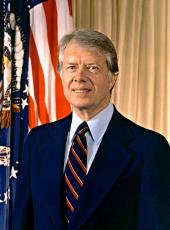
Executive Office of the President Remarks to Reporters on Transmitting a Reorganization Plan to the Congress
Good afternoon, everybody.
Today we have submitted to the Congress the first in a series of recommendations for reorganizing the executive branch of Government. We are starting off with perhaps the most difficult one of all for me. That's the Executive Office of the President and the White House staff.
It's difficult because of the closeness of myself to the people involved. It's also difficult because, for many years, as the Congress and other elements in the Government have evolved special programs that cut across many departments' lines, they've put them in the Executive Office of the President. The closeness of the President is supposed to add stature to their influence and also permits them to deal with several departments simultaneously without any doubt about where the authority lies.
The basic thrust of the proposals today involving the Executive Office of the President is to strengthen Cabinet government. I'm very much opposed to having a concentration of large numbers of people and authority in the White House staff. I much prefer that Cabinet officers make their own decisions, manage their own departments, and that the coordinating effort rests in me.
We've initiated and maintained a weekly Cabinet meeting that further strengthens the Cabinet-level authority and responsibility. At the same time, these changes we are proposing today, which will be outlined by Bert Lance, the head of OMB, provide an unimpeded access of information, advice, counsel, criticism to me--a free flow of information from many diverse sources that eventually arrive on my desk, or with consultations with the President himself if they can't be resolved at a lower level of Government.
The historical authorized level of the White House staff has been about 485. I think the day of the election last November there were 489 people who were working in the White House, which is less than there had been some time in the past. We are proposing to cut that down to 351, a very drastic reduction amounting to about 28 percent.
In the Executive Office of the President we are reducing the overall staff size, including OMB and other entities that are very difficult to reduce, from 1,712 down to 1,459.
We have had, in the past, 19 separate units of Government within the Executive Office of the President. I have already eliminated two of those, and this proposal will eliminate seven others. This remaining 10 elements that work directly with me, we believe, are needed here, because there is no other logical place for them in Government and because I need their constant advice and counsel, almost on a daily basis, to make decisions that accrue to the President as a responsibility.
The 10 that are remaining will be simplified, and I think that this overall thrust will be a very successful effort to make the Executive Office of the President a model that can be emulated as we proceed aggressively now to reorganize other parts of the Federal Government.
Bert Lance will be here with his staff to answer your questions of a specific nature, but I am very pleased at the work they've done and believe that we have made the right decision that will stand us in good stead in the future.
I might point out that we've had additional responsibilities that have caused some increase in staffing. Under Jack Watson, we now have a superb interrelationship among Cabinet officers, since they are elevated to a much greater degree of importance than in the past. And this same additional group, which did not exist before, deals directly with Governors, mayors, county officials, local officials. And this is a very welcome addition to the Executive Office of the President.
We also have a few additional personnel here who work exclusively on the reorganization of the Government itself. But even including those additional people, this is very severe and, I think, adequate reduction.
I might say in closing that we think that every change we've made will lead to greater productivity of the right decisions and management of the Government and will also mean that each person has a much clearer definition of responsibility and authority than has been in the past.
I want to thank you for your attention and now turn the program over to Bert Lance.
Note: The President spoke at 1: 38 p.m. in the Briefing Room at the White House. Following his remarks, Bert Lance, Director of the Office of Management and Budget, and A.D. Frazier, Jr., Project Manager of the Executive Office of the President Reorganization Study Group, held a news briefing for reporters on the reorganization plan.
Jimmy Carter, Executive Office of the President Remarks to Reporters on Transmitting a Reorganization Plan to the Congress Online by Gerhard Peters and John T. Woolley, The American Presidency Project https://www.presidency.ucsb.edu/node/243143

